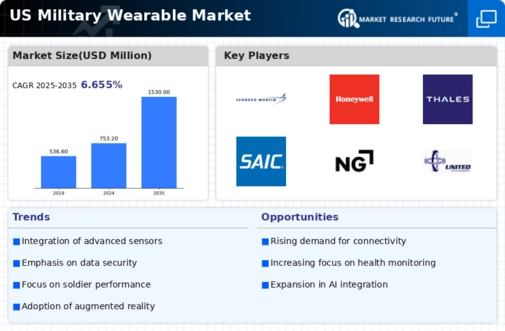Increased Defense Budgets
The military wearable market in the US is experiencing growth driven by increased defense budgets. The US government has allocated substantial funds to modernize military capabilities, with a focus on advanced technologies. In fiscal year 2025, the defense budget reached approximately $850 billion, with a significant portion earmarked for research and development of wearable technologies. This financial commitment indicates a strong emphasis on enhancing soldier performance and operational efficiency. As a result, companies in the military wearable market are likely to benefit from government contracts and funding opportunities, fostering innovation and the development of cutting-edge wearable solutions. The infusion of capital into the military sector is expected to stimulate competition among manufacturers, ultimately leading to improved products and services in the military wearable market.
Rising Demand for Real-Time Data
The military wearable market is increasingly influenced by the rising demand for real-time data among military personnel. Wearable devices equipped with sensors and communication technologies enable soldiers to access critical information instantaneously. This capability enhances situational awareness, decision-making, and operational effectiveness on the battlefield. According to recent estimates, the market for wearable technology in defense is projected to grow at a CAGR of 10% through 2027. The integration of data analytics and artificial intelligence into these wearables further amplifies their utility, allowing for predictive insights and improved mission outcomes. As military operations become more complex, the need for real-time data is likely to drive innovation and investment in the military wearable market.
Emphasis on Soldier-Centric Design
The military wearable market is shifting towards soldier-centric design principles. Manufacturers are increasingly prioritizing the comfort, usability, and functionality of wearable devices to ensure they meet the needs of military personnel. This focus on user experience is crucial, as wearables must be practical and effective in demanding environments. Recent surveys indicate that over 70% of soldiers prefer wearables that are lightweight and easy to operate. As a result, companies are investing in research and development to create innovative designs that enhance soldier performance without compromising mobility. This trend towards soldier-centric design is likely to drive growth in the military wearable market, as it aligns with the overarching goal of improving operational effectiveness.
Focus on Enhanced Training Solutions
The military wearable market is significantly impacted by the focus on enhanced training solutions for military personnel. Wearable technologies are increasingly utilized in training environments to simulate real-world scenarios, providing soldiers with immersive experiences. These devices can track performance metrics, monitor physiological responses, and offer feedback to improve skills and readiness. The US military has recognized the value of integrating wearables into training programs, leading to a projected increase in spending on training technologies. In 2025, the budget for training and simulation technologies is expected to exceed $5 billion, reflecting a commitment to preparing soldiers for modern warfare. This trend suggests that the military wearable market will continue to evolve, driven by the need for effective training solutions.
Integration of Health Monitoring Features
The military wearable market is increasingly integrating health monitoring features into devices for military personnel. These wearables are designed to track vital signs, physical activity, and overall health status, providing valuable insights into soldier well-being. The US military has recognized the importance of maintaining soldier health, particularly in high-stress environments. As a result, the demand for wearables with health monitoring capabilities is on the rise. Recent reports suggest that the market for health-focused wearables in defense could reach $1 billion by 2026. This integration of health monitoring features not only enhances soldier safety but also contributes to improved performance and mission readiness. Consequently, the military wearable market is likely to see continued growth as health monitoring becomes a standard feature in wearable technologies.






















Leave a Comment